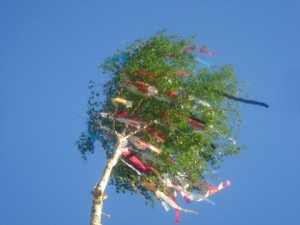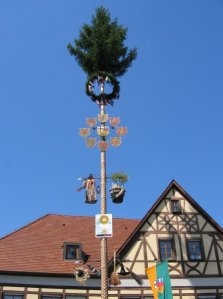Walpurgisnacht and May Day April 29, 2009
Posted by Jill (@bonnjill) in German culture.trackback
I miss Germany, but I really miss Germany during the holidays that I celebrated when I lived there. Two of those holidays occur within 24 hours of each other: Walpurgisnacht and May Day.
 Walpurgisnacht (Walpurgis Night) is a traditional religious holiday celebrated by pagans and Satanists, as well as Roman Catholics, on April 30 or May 1 in large parts of Central and Northern Europe. Walpurgisnacht gets its name from Saint Walburga (or Walpurga), a woman born in what is now England in 710. Saint Walpurga traveled to Germany and became a nun at the convent of Heidenheim in Württemberg. She was made a saint following her death in 778 (or 779), and May 1 is her saint day.
Walpurgisnacht (Walpurgis Night) is a traditional religious holiday celebrated by pagans and Satanists, as well as Roman Catholics, on April 30 or May 1 in large parts of Central and Northern Europe. Walpurgisnacht gets its name from Saint Walburga (or Walpurga), a woman born in what is now England in 710. Saint Walpurga traveled to Germany and became a nun at the convent of Heidenheim in Württemberg. She was made a saint following her death in 778 (or 779), and May 1 is her saint day.
In Germany the Brocken, the highest peak in the Harz Mountains, is considered the focal point of Walpurgisnacht. Witches (Hexen) and devils (Teufel) allegedly gather on the mountain (also called the Blocksberg), which is often shrouded in mist and clouds, lending it a mysterious atmosphere that has contributed to its legendary status. The tradition of the witches gathering on the Brocken was immortalized in Goethe’s Faust: “To the Brocken the witches ride…” (“Die Hexen zu dem Brocken ziehn…“)
In its Christian version, the former pagan festival in May became Walpurgis, a time to drive out evil spirits—usually with loud noises. Bonfires were built to keep away the dead and chaotic spirits that were said to walk among the living then. The bonfires reflect the holiday’s pagan origins and the human desire to drive away the winter cold and welcome spring. This is followed by the return of light and the sun as celebrated during May Day. I experienced Walpurgisnacht for the first time when I lived in Austria. We went to a bonfire and jumped over the bonfire to welcome spring. When I was in grad school at Kent we did a translation about the Brocken, so my interest has always been piqued by this holiday.
May Day is observed on May 1st in many countries around the globe as the International Workers’ Day, but I never saw too many labor protests in Germany. Even though the day was inspired by labor protests in the U.S., the holiday has historically had special importance in socialist and communist countries, which is one reason it is not observed in May in America. In Germany, May Day is a national holiday and an important day, partly because of Blutmai (“bloody May”), a labor protest in which 32 people died and 80 people were injured, in 1929. The holiday also tends to be a day of demonstrations that often turn into clashes between the demonstrators (hooligans) and the police in Berlin and other large cities. If the weather is nice, law-abiding people use the day for picnicking or relaxing with the family.
 In addition to being an international day of labor and protests, May 1 is also celebrated in the Rhineland by the delivery of a Maibaum (May tree) covered in streamers to the house of a girl the night before. The unmarried men of the villages gather together to chop down trees and help each other deliver them to a love interest’s house. A tree wrapped only in white streamers is a sign of dislike. I never saw many of those. Anyone who would go to the trouble of gathering trees probably wouldn’t put forth the effort for someone they disliked. On leap years, it is the responsibility of the females to place the Maibäume, though the males are still allowed and encouraged to do so. They also placed a tall Maibaum or Maypole in the town square. In small towns virtually the entire population
In addition to being an international day of labor and protests, May 1 is also celebrated in the Rhineland by the delivery of a Maibaum (May tree) covered in streamers to the house of a girl the night before. The unmarried men of the villages gather together to chop down trees and help each other deliver them to a love interest’s house. A tree wrapped only in white streamers is a sign of dislike. I never saw many of those. Anyone who would go to the trouble of gathering trees probably wouldn’t put forth the effort for someone they disliked. On leap years, it is the responsibility of the females to place the Maibäume, though the males are still allowed and encouraged to do so. They also placed a tall Maibaum or Maypole in the town square. In small towns virtually the entire population  turns out for the ceremonial raising of the Maypole and the festivities that follow, with Bier und Wurst of course. I never saw any Morris or Maypole dancing in Bonn. I know how to do it though, having learned it here in the U.S. in grade school. I loved watching the trucks filled with trees drive through the village as I biked home late at night and then waking up in the morning and seeing trees propped up against the houses and the town square decorated. It always seemed so magical.
turns out for the ceremonial raising of the Maypole and the festivities that follow, with Bier und Wurst of course. I never saw any Morris or Maypole dancing in Bonn. I know how to do it though, having learned it here in the U.S. in grade school. I loved watching the trucks filled with trees drive through the village as I biked home late at night and then waking up in the morning and seeing trees propped up against the houses and the town square decorated. It always seemed so magical.
Felix Mendelssohn wrote Die erste Walpurgisnacht (The First Walpurgis Night) and based the words on a poem by Johann Wolfgang von Goethe. Mendelssohn completed an initial version in 1831. It was extensively revised and published as his Opus 60 in 1843. The text describes pagan rituals of the Druids in the Harz mountains in the early days of Christianity. If you have a bit of time, you might enjoy listening to this in the background while you work.
Thanks to Wikipedia and About.com for the background to this post.


Thanks for this post! I enjoyed the Mendelssohn while working this May Day weekend. I live just few hours north of the Harz and my husband’s son and his girlfriend attended the Walpurgisnacht celebrations there this year. I’m looking forward to his report!
Bei uns in Braunlage ist auch wieder richtig was los. In der Nacht zum 1. Mai fliegen wieder die Hexen durch die Luft. Ein Video seht Ihr hier: http://www.harzidyll.de/veranstaltungen-harz-braunlage.html
Oh I love this.
~another overworked translator
Thanks for posting the link on Facebook, Jill! Great article!!
~one more overworked translator….
Revisiting this post! Thanks again. Attending a Walpurgisnacht gathering in the Harz is still on my list of things to do before I can’t do them anymore.